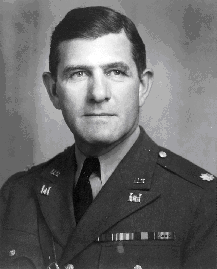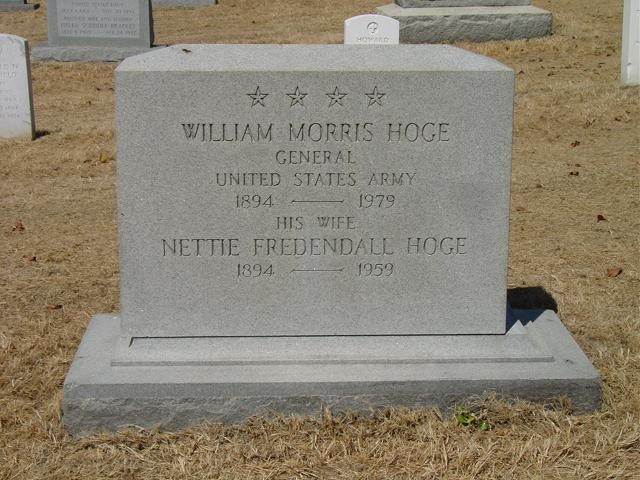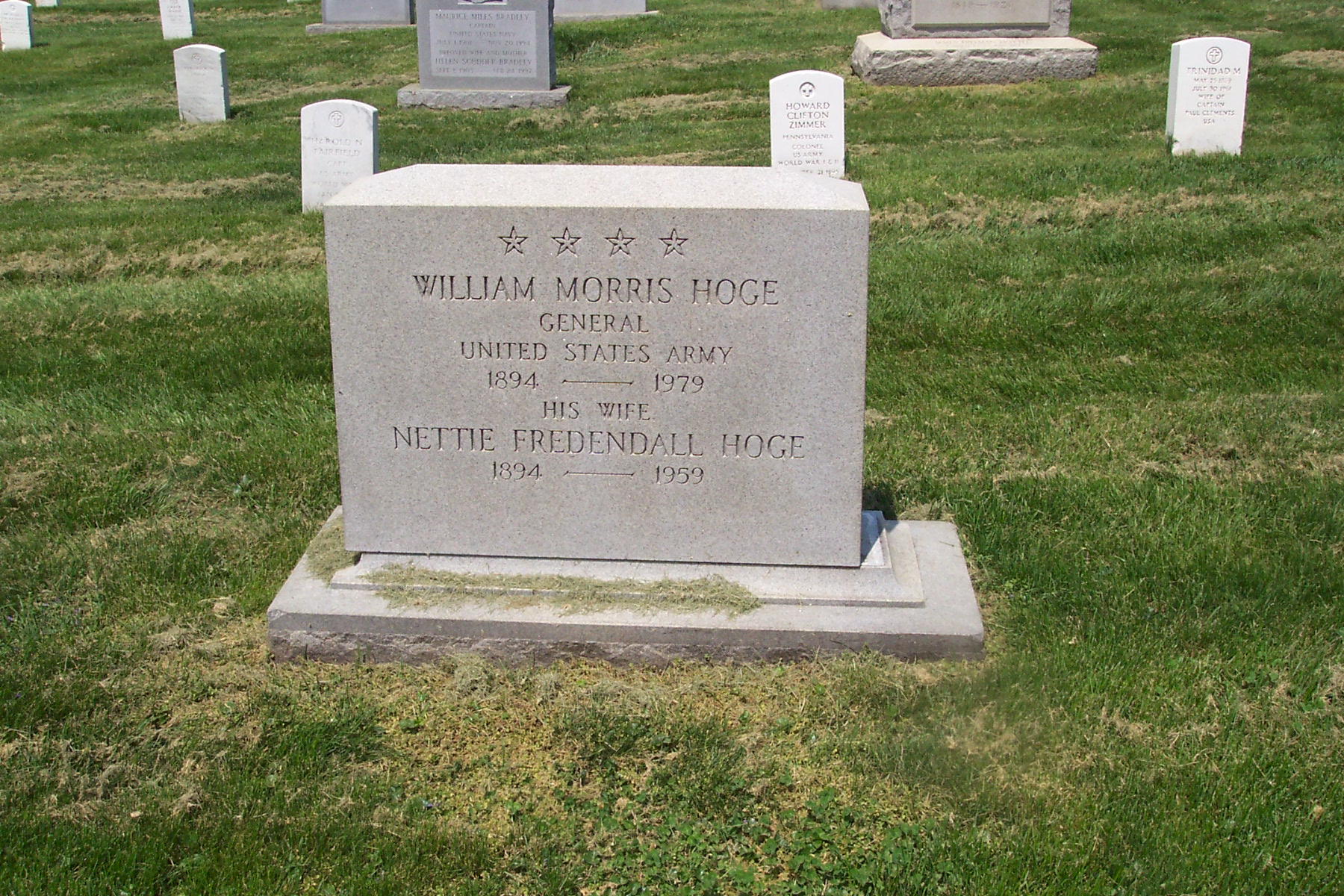William M. Hoge’s career reflects the diversity of duties that an Engineer officer may be called upon to perform — soldier, engineer, combat leader, and senior commander. It is a career that spans the spectrum of responsibilities from
military and training education, to all facets of peacetime civil and military engineering, to combat in three wars.
Upon graduating from the US Military Academy in June 1916, Hoge served briefly on the Mexican border in Texas with the 1st Engineers before being assigned to duty with the newly organized 7th Engineer Regiment, first in the United States and then in France during the First World War. There he earned the Distinguished Service Cross and Silver Star for extraordinary heroism under fire during a bridging operation in the Meuse-Argonne Offensive (October-November 1918). Before leaving Europe in July 1919, he directed drilling, salvage, and construction work in France and Luxembourg.

Once back in the United States, Hoge spent much of the next 20 years in military education and training and in Civil Works assignments. After two years as assistant professor of military science and tactics at Virginia Military Institute he was assigned to Massachusetts Institute of Technology from 1922 to 1923 for advanced work in civil engineering. A brief assignment to the Rock Island Engineer District in Illinois was followed by a two-year tour of duty at the Engineer School, Fort Humphreys (now Fort Belvoir), Virginia, where he was an instructor in tactics. Following a year (August 1927-June 1928) at the Command and General Staff School at Fort Leavenworth, Kansas, Hoge went to the Infantry School at Fort Benning, Georgia, as the Engineer instructor and commander of the Engineer troops. It was there that Hoge served with and came to know many of the men who would lead the US Army during World War II, soldiers such as George C. Marshall, Omar N. Bradley, J. Lawton Collins, Matthew B. Ridgway, and James Van Fleet. His years at Fort Benning ended the educational phase of Hoge’s Army career.
With his assignment to the Mississippi River Commission (MRC) in Vicksburg, Mississippi, from July 1931 to September 1932, Hoge entered fully into the Civil Works phase of his career. He was then transferred to the
Memphis Engineer District where he served as an assistant district engineer under Brehon B. Somervell until September 1933. Hoge was then District Engineer at Memphis until May 1935. From June 1935 to November 1937, he commanded the 14th Engineers, Philippine Division, at Fort William McKinley. During the latter part of this tour, he also served as the Division Engineer, Philippine Division, and as the Chief Engineer of the Philippine Army under GeneralDouglas MacArthur, who was then the military advisor to the Philippine Commonwealth. Hoge was promoted to lieutenant colonel before returning to the United States in January 1938 as the District Engineer at Omaha, Nebraska. While District Engineer at Omaha, he was responsible for the early planning and development of the large dams on the Missouri River.
In December 1940, with Europe already embroiled in a second world war and the United States beginning to mobilize its military forces, Hoge was assigned to command the Engineer Replacement Training Center at Fort Belvoir, Virginia. At Fort Belvoir, with the assistance of Paul W. Thompson, another Engineer officer, he built the first obstacle course for military and physical fitness training. After he saw the course, General George C. Marshall, Chief of Staff of the
Army, ordered similar courses for all Army training camps.
In February 1942, Hoge was pulled out of Fort Belvoir and given a seemingly impossible task-to build a military highway from Dawson Creek, British Columbia, to Big Delta, Alaska, through largely unmapped and at places impassable territory. Promoted to Brigadier General in March 1942, he initially had complete control over the construction from Dawson Creek to Fairbanks—a distance of more than 1,500 miles. The distances involved and lack of reliable communications resulted in a division of responsibility for the highway in May 1942. Hoge was left with the Northern, or Whitehorse, Sector that ran across one of the most inaccessible and rugged areas of North America from Watson Lake, British Columbia, to Big Delta, Alaska. Although he was reassigned in September 1942, before the Alaska Highway was actually opened to truck traffic, Hoge was largely responsible for driving the pioneer road to completion that year.
In October 1942, Hoge was assigned to the Armored Force at Fort Knox, Kentucky. After a brief orientation, he moved to Fort Riley, Kansas, in November 1942 to take command of Combat Command B, 9th Armored Division, under his old friend from World War I, Major General John W. Leonard. He remained with the 9th until September 1943 when he was again reassigned, this time to command the 4th Engineer Special Brigade, an amphibious Engineer unit. A month later he received orders to proceed to England as commander of the 5th Engineer Special Brigade, which was to participate in the Allied invasion of the Continent, Operation OVERLORD. In March 1944, Hoge was given command of the Provisional Engineer Special Brigade Group, which included the 5th Engineer Special Brigade, now under Colonel Paul W. Thompson, and the 6th Engineer Special Brigade. His mission was to prepare for and conduct landing operations with the assault divisions on D-day on OMAHA Beach and then develop the beachhead to support the combat troops once they were ashore. On 6 June 1944, Hoge’s command successfully carried out its duties and played a significant part in securing theinitial foothold at OMAHA Beach. He remained in charge of the beachhead until July 1944 when he assumed command of the 16th Port, a Communications Zone unit responsible for supporting the VIII Corps in the Brittany Peninsula and then for clearing the captured French Channel ports, including Le Havre, and establishing supply lines for the American armies fighting in France. Hoge cared little for this work and soon requested transfer to a combat unit. He contacted John Leonard, whose 9th Armored Division had recently landed in France, and Leonard offered him his old command. After a brief reassignment to the 12th US Army Group in October, Hoge rejoined the 9th Armored in November 1944, just in time to gain fame for his stubborn defense of St. Vith during the Battle of the Bulge. In the critical and savage fighting at St. Vith, Hoge combined with the 7th Armored Division’s Combat Command B, under Colonel Bruce C. Clarke, another Engineer officer, to hold off the vastly superior Germans from 16 to 24 December. The defensive fighting at St. Vith bought the valuable days that the Americans and British required to reestablish their defenses and contain Adolf Hitler’s Ardennes Offensive. For his actions at St. Vith, Hoge received a Distinguished Service Medal (DSM).
On 7 March 1945, the leading elements of Combat Command B seized the Ludendorff Railroad Bridge over the Rhine River at Remagen. Quickly exploiting his good fortune in capturing the only major bridge over the Rhine that was still standing, Hoge pushed over the river and established a firm bridgehead on the eastern shore. For this he received an Oak Leaf Cluster to his DSM and later in March was given command of the 4th Armored Division in George S.
Patton’s Third Army. On 2 May 1945, he was promoted to the rank of Major General.
After the war and a special assignment with the Operations Division, War Department General Staff (July-December 1945), Hoge was assigned for several weeks as the Division Engineer, New England Engineer Division (December
1945-January 1946), before being given command of The Engineer Center at Fort Belvoir (January 1946-June 1948). He was appointed Commanding General, US Troops in Trieste (TRUST) in June 1948. He remained in Trieste until General Matthew B. Ridgway, commander of Eighth US Army in Korea, summoned him to command IX Corps in March 1951. In June 1951 he was promoted to Lieutenant General, and his distinguished service in the Korean fighting earned him another Oak Leaf Cluster for his DSM.
From February 1952 to March 1953, Hoge commanded the Fourth Army at Fort Sam Houston, Texas. In March 1953, General J. Lawton Collins, Army Chief of Staff, asked Hoge to take command of the Seventh Army in Germany,
the major American ground component in North Atlantic Treaty Organization (NATO). In September 1953, he received his fourth star upon becomingCommander-in-Chief US Army, Europe (USAREUR). He retired on 31 January 1955.
In February 1957, Hoge became Chairman of the Board of Interlake Iron Corporation of Cleveland, Ohio, finally retiring from that job in 1965. He loved outdoor sports, especially hunting, fishing, and riding. Also he enjoyed his dogs
and seldom failed to take them on daily walks until the last few years of his life.
In 1975 his failing health led him to move in with his son, Colonel George F. Hoge, US Army (Retired), in Easton, Kansas. Beside curtailing his physical activity and independence, Hoge’s deteriorating health affected his eyesight and deprived him of his ability to read. Throughout his life, he was an avid reader, especially of military history and biography. General Hoge died at Munson Army Hospital, Fort Leavenworth, Kansas, on 29 October 1979 at the age of 85.
General William M. Hoge was remarkable in that he accomplished so much so well during his career. Certainly his extensive achievements in peace and war-in military engineering, combat, military education and training, Civil
Works, and senior command-are goals not just for Engineers but for all Army officers to strive toward in their military careers.
His close friend and classmate from the Class of 1916, Major General Thomas D. Finley, put it best: In my opinion, Bill Hoge’s service in War and Peace has been unequaled by anyone in the Army in its diversity, the challenges it posed and the value to the Service and the Country. He has known so many people and influenced so many lives, both civilian and military . . . I can say it, and not just as an old and dear friend, that he was the best man I have ever known, and the best soldier.
William M. Hoge (January 13, 1894–29 October 1979) was a General of the United States Army.
On graduating from West Point in 1916, William M. Hoge was commissioned into the Corps of Engineers and commanded a company of the 7th Engineers at Fort Leavenworth in 1917–18. During World War I, Hoge received the Distinguished Service Cross personally from General John Pershing for heroic action under fire as a Battalion Commander in the Meuse-Argonne offensive. During the interwar years, he graduated from the Massachusetts Institute of Technology and from the Command and General Staff School.
Hoge directed one of the great engineering feats of World War II, the construction of the 1,519-mile (2,450 km) ALCAN Highway in nine months. Later, in Europe, he commanded the Provisional Engineer Special Brigade Group in the assault on Omaha Beach. He then directed Combat Command B, 9th Armored Division, in its heroic actions in the Ardennes and in its celebrated capture of the Remagen Bridge over the Rhine. By war’s end, Hoge commanded the 4th Armored Division.
During the Korean conflict, at General Matthew Ridgway’s request, Hoge commanded the U.S. IX Corps. General Hoge achieved his senior command in the Army as Commander in Chief, U.S. Army, Europe. He retired from active duty in January 1955.
Hoge moved to his son’s farm in Kansas in October 1975 and he died suddenly on 29 October 1979 at Munson Army Hospital, Fort Leavenworth.
HOGE, NETTIE F W/O WILLIAM MORRIS
- DATE OF BIRTH: 03/30/1894
- DATE OF DEATH: 07/10/1959
- BURIED AT: SECTION 2 SITE 3405 LH
ARLINGTON NATIONAL CEMETERY - WIFE OF WM HOGE, GEN USA
Michael Robert Patterson was born in Arlington and is the son of a former officer of the US Army. So it was no wonder that sooner or later his interests drew him to American history and especially to American military history. Many of his articles can be found on renowned portals like the New York Times, Washingtonpost or Wikipedia.
Reviewed by: Michael Howard


